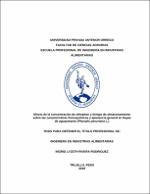Efecto de la concentración de ethephon y tiempo de almacenamiento sobre las características fisicoquímicas y apariencia general en bayas de aguaymanto (physalis peruviana L.)

View/Open
Download
(application/pdf: 735.3Kb)
(application/pdf: 735.3Kb)
Date
2019Author(s)
Rivera Rodriguez, Ingrid Lyzeth
Metadata
Show full item recordAbstract
Se evaluó el efecto de la concentración de ethephon y tiempo de
almacenamiento sobre el color, la firmeza, la acidez titulable, el contenido de
fenoles totales y la apariencia general en bayas de aguaymanto. Los frutos
fueron cosechados en el fundo Santa Rosa de la provincia de Celendín, región
Cajamarca (Perú), inmediatamente se trasladaron al Laboratorio de
Tecnología de Alimentos de la Universidad Privada Antenor Orrego, donde se
retiró el capuchón, seleccionaron, clasificaron, dividieron en cuatro grupos y
se aplicó diferentes concentraciones de ethephon (100, 300 y 600 ppm)
durante 1 min; se pesaron y envasaron en bandejas “clamshell” con tapa
ventilada. Luego fueron refrigerados a 3 ºC durante 30 días; se consideró una
muestra control. Los días 0, 5, 10, 20 y 30 fueron evaluados el color, la firmeza,
la acidez titulable, el contenido de fenoles totales y la apariencia general. El
análisis de varianza mostró efecto significativo (p < 0.05) de la concentración
de ethephon y tiempo de almacenamiento sobre las variables paramétricas
estudiadas. La prueba de Duncan determinó que el tratamiento de 300 ppm
de ethephon obtuvo la mejor luminosidad L* y cromaticidad b*, mejor firmeza
y acidez titulable. Con el tratamiento de 600 ppm de ethephon obtuvo la mejor
cromaticidad a* y mayor contenido de fenoles totales. En la apariencia general,
la prueba de Friedman se evidenció efecto significativo entre los tratamientos
en los días 5, 10 y 20 de almacenamiento. Además, el tratamiento 300 ppm de
ethephon presentó la mayor moda con 8 puntos (correspondiente a me agrada
mucho) y un promedio de 6.60 puntos a los 30 días de almacenamiento a 3
ºC. Se consideró la concentración de 300 ppm como mejor tratamiento al
presentar mejores valores de luminosidad L* y cromaticidad a*, firmeza, acidez
titulable y apariencia general. The effect of ethephon concentration and the storage time on color, firmness,
titratable acidity, content of total phenols and general appearance in
aguaymanto berries was evaluated. The fruits were harvested in Santa Rosa
farm located at the province of Celendín, region Cajamarca (Perú); immediately
they were moved to the Food Technology Laboratory of the Universidad
Privada Antenor Orrego, where the calyx was removed; they were selected,
classified and divided into four groups, then different concentrations of
ethephon (100, 300 and 600 ppm) were applied for 1 min; they were weighed,
and packed in ““clamshell““ trays with a ventilated cover. Then they were
refrigerated at 3 °C for 30 days; a control sample was considered. On days 0,
5, 10, 20 and 30; color, firmness, titratable acidity, content of total phenols, and
general appearance were evaluated. The analysis of variance showed a
significant effect (p < 0.05) of ethephon concentration and storage time on
parametric variables studied. The Duncan test determined that the treatment
of 300 ppm of ethephon obtained the best luminosity L * and chromaticity b *,
better firmness and titratable acidity. With the treatment of 600 ppm of
ethephon obtained the best chromaticity a* and highest content of total
phenols. In the overall appearance, the Friedman test showed significant effect
between treatments on days 5, 10 and 20 of storage. In addition, the treatment
300 ppm of ethephon showed the highest mode with 8 points (corresponding
to I like it very much) and an average of 6.60 points at 30 days of storage at 3
ºC. The concentration of 300 ppm was considered as the best treatment at
showed the best results of luminosity L* and chromaticity b*, firmness, titratable
acidity and general appearance.
Subject
Collections
- Industrias Alimentarias [153]

